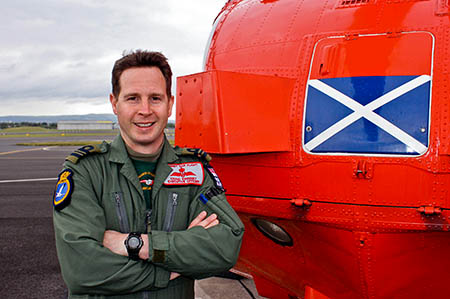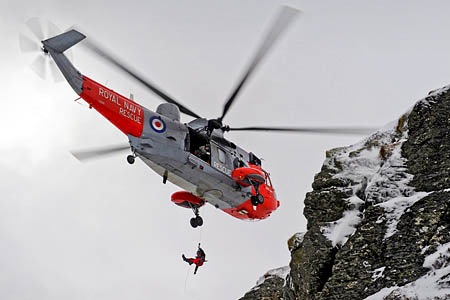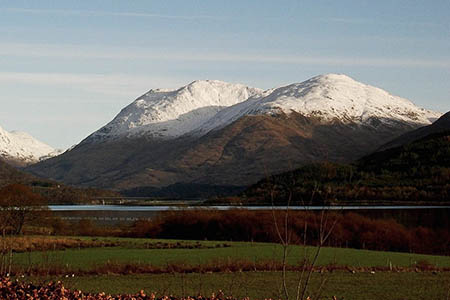A rescue helicopter commander has been honoured for his grit, determination and courage during a flight to rescue an injured man on a Highland mountain.
Royal Navy Sea King pilot Lieutenant Commander Craig Sweeney used all his experience in a rescue mission described as one of his most challenging to pluck an injured walker from Beinn Sgulaird in Argyll.
For his airmanship and courage in flying his helicopter during the incident in December 2011, Lt Cdr Sweeney will receive the Air Force Cross.
The rescue took place in darkness and blizzard conditions on the 937m (3,074ft) mountain, which lies between Glen Creran and Glen Etive, but Royal Navy bosses said despite operating in some of the most difficult conditions encountered, the pilot never put his aircraft and crew in danger.
In blizzard conditions, plummeting temperatures and pitch darkness, the team from HMS Gannet at Prestwick in Ayrshire flew its Sea King Mark 5 helicopter to the aid of walker Dr Gareth Bradley who had a reported broken ankle.
Beinn Sgulaird lies about 10 miles north-east of Oban.
Lt Cdr Sweeney used years of Commando Helicopter Force experience in similar conditions in the Arctic and Afghanistan, allowing him not only to reassure his crew, but to command successfully the difficult mission.
The four-strong team was directed from routine training about 4pm on the day.
The climber was in a precarious position near the 3,074ft summit and it was a race against time for the Prestwick-based Sea King helicopter in extreme conditions flying very close to the mountain’s rock face to recover him to safety.
Lt Cdr Sweeney said: “I am very honoured, humbled and proud to receive this award.
“It was a thorough team effort throughout and it reflects the efforts of all on board that day, not just me.
“It was very dark and very cold. The cloud base was at around 1,000ft [300m] when we arrived and it really did look doubtful as to whether we would be able to fly up the mountain at all.
“However, what was also clear was that the casualty Dr Bradley had a serious ankle injury of some kind and was not going to be able to walk down the mountain. The mountain rescue team felt it was unlikely he would survive a night on the hill.
“Taking that into account and the continuing harsh wintry conditions, we put on our night vision goggles, and set to work to try and get through.
“We collected three members of Oban Mountain Rescue Team and began a slow hover-taxi up the mountain.
“Above 1,500ft we were into cloud and recirculating snow, which made for extremely delicate flying. Essentially our only visual references came from the mountain itself.
“And in order to see this reference which would allow me and the crew to ascend safely, we had to go extremely close to the rock face throughout the whole journey up the mountain – that’s how bad the visibility was.
“All around us was nothing but swirling snow and we were very close to whiteout conditions – essentially, as a pilot I could see nothing.
“And a rock face is a pretty formidable hazard. Coupled with the snow and swirling cloud whipped up by the downwash from the rotors, it made the conditions exceptionally challenging.
“It was intense flying which relied on dozens of years of the whole crew’s experience and expertise, and really full-on team work.
“I had trained and worked with my winchman of that day all around the world and, most notably, had practised this very technique both in the Arctic conditions of Norway and the desert sands of Afghanistan, where you get a very similar thing happening when the rotors kick up the fine sand particles.
“And it all led to us being able to get the job done safely and as quickly as possible in some of the worst conditions we had experienced.
“It was a long, slow process and it paid off when we got just below the summit where we found Dr Bradley.
“He had had the forethought to shine a torch, which we were just able to make out, and together I and my co-pilot Lieutenant Mark Wielopolski managed to get the helicopter into a position where we could set down the three members of the mountain rescue team and our aircrewman.
“Conditions underfoot for the rescuers were absolutely treacherous and it was also extremely steep at that point.
“Our winchman Chief Petty Officer Jason Bibby was also a qualified paramedic and was able to make immediate on-site assessment of the casualty.
“It appeared the climber had slipped and hurt his leg, and had been lucky enough to fall in an area where he had enough mobile coverage to raise the alarm.
“The casualty had managed to keep himself warm in a bivvy bag, so he wasn’t suffering too badly from the cold. But I think he was pretty pleased and relieved to see Jason, the MRT guys and our helicopter.”
The team transferred the rescuers down to the base of the mountain before delivering the casualty to Belford Hospital in Fort William, where they arrived with a mere five minutes of fuel left. They were able to refuel at Corpach.
HMS Gannet’s commanding officer, Lt Cdr Andy Drodge, in his citation for the award, said: “Sweeney demonstrated exceptional levels of leadership, grit and composure enabling him to fly the most demanding sortie of his career.
“He constantly reassured his team and never once did he fly in a manner that put the aircraft in danger.
“In doing so it allowed his team to have absolute confidence in his conduct and decisions, thereby giving focus to the rescue.
“He knew if he applied his experience of flying in extreme environments gained as a Commando pilot in the Arctic it would be possible to fly R177 up the mountain deliberately entering cloud in order to effect the rescue.
“The rescue of the climber, stranded 2,400ft up, in cloud, on a harsh winter night required outstanding airmanship and courage.”
Dr Bradley, who now lives and works in Scotland as an engineering lecturer at the University of the Highlands and Islands in Perth, praised the rescuers saying: “I am very grateful to all those involved who risked their safety to assist me.
“The fact that my rescue was successful was a credit to all involved.
“They were amazing; very professional. They reassured me and talked me through exactly what was happening. If it wasn’t for these guys I might not be here today.
“I was extremely relieved to see that helicopter and the aircrewman and mountain rescuers who were winched down to me.
“I pass on my thanks, once again, to Lieutenant Commander Sweeney and his crew.”
Dr Bradley continues to walk and climb in the Scottish mountains and he has now moved to Scotland – he was working at Liverpool John Moores University at the time of the incident.
After his life-saving experiences on Beinn Sgulaird, he hopes to be able to give something back to the rescue community in the very near future by joining a mountain rescue team.
Lt Cdr Sweeney joined HMS Gannet at Prestwick in Ayrshire in December 2010 as the executive officer – second in Command – and now lives close to the unit in Alloway with his wife and three children.
As well as marking the 60th anniversary of Royal Navy helicopter search and rescue in 2013, it is also the pilot’s last year in the Senior Service – he will make his last flight at the end of April.


